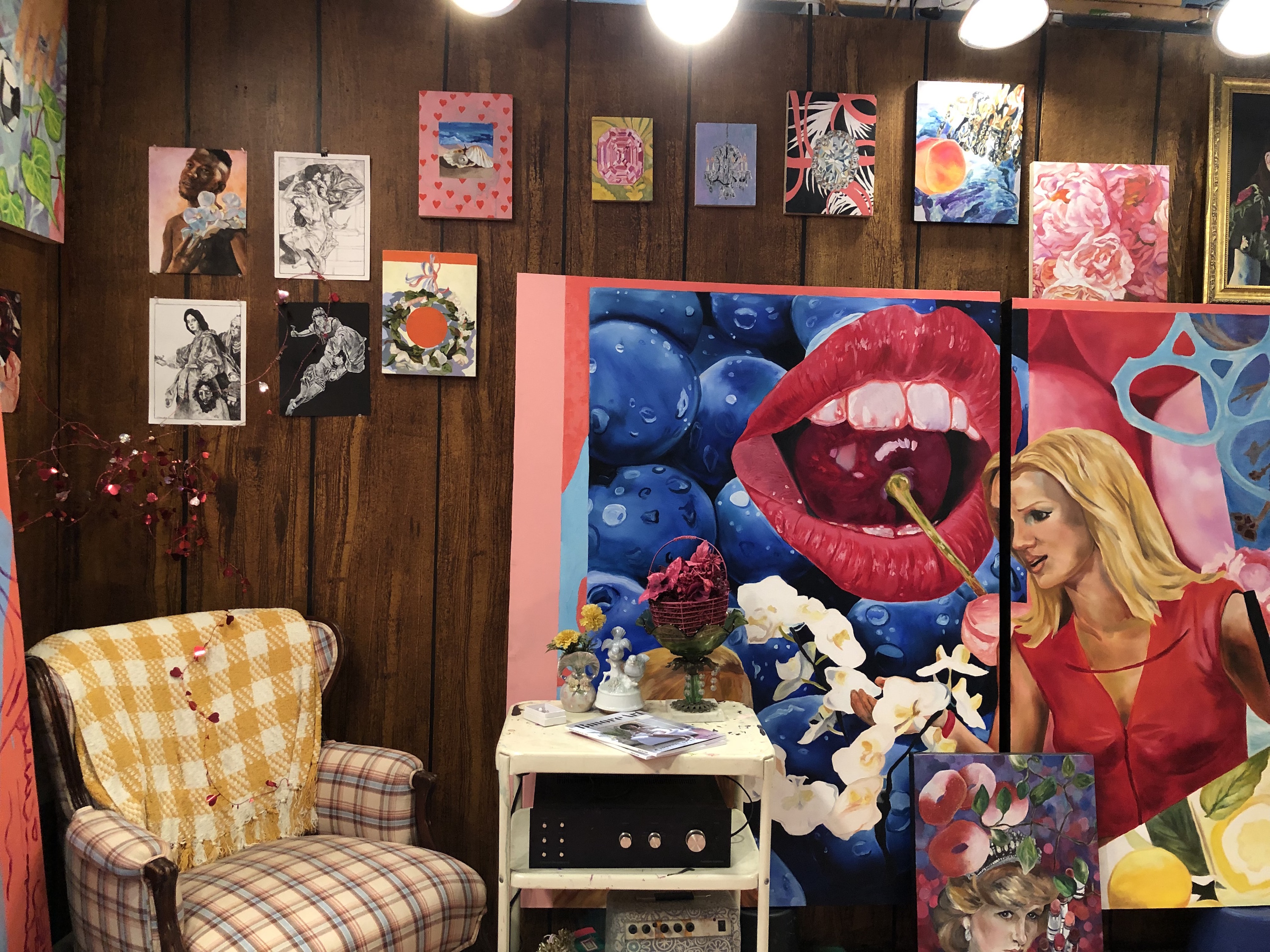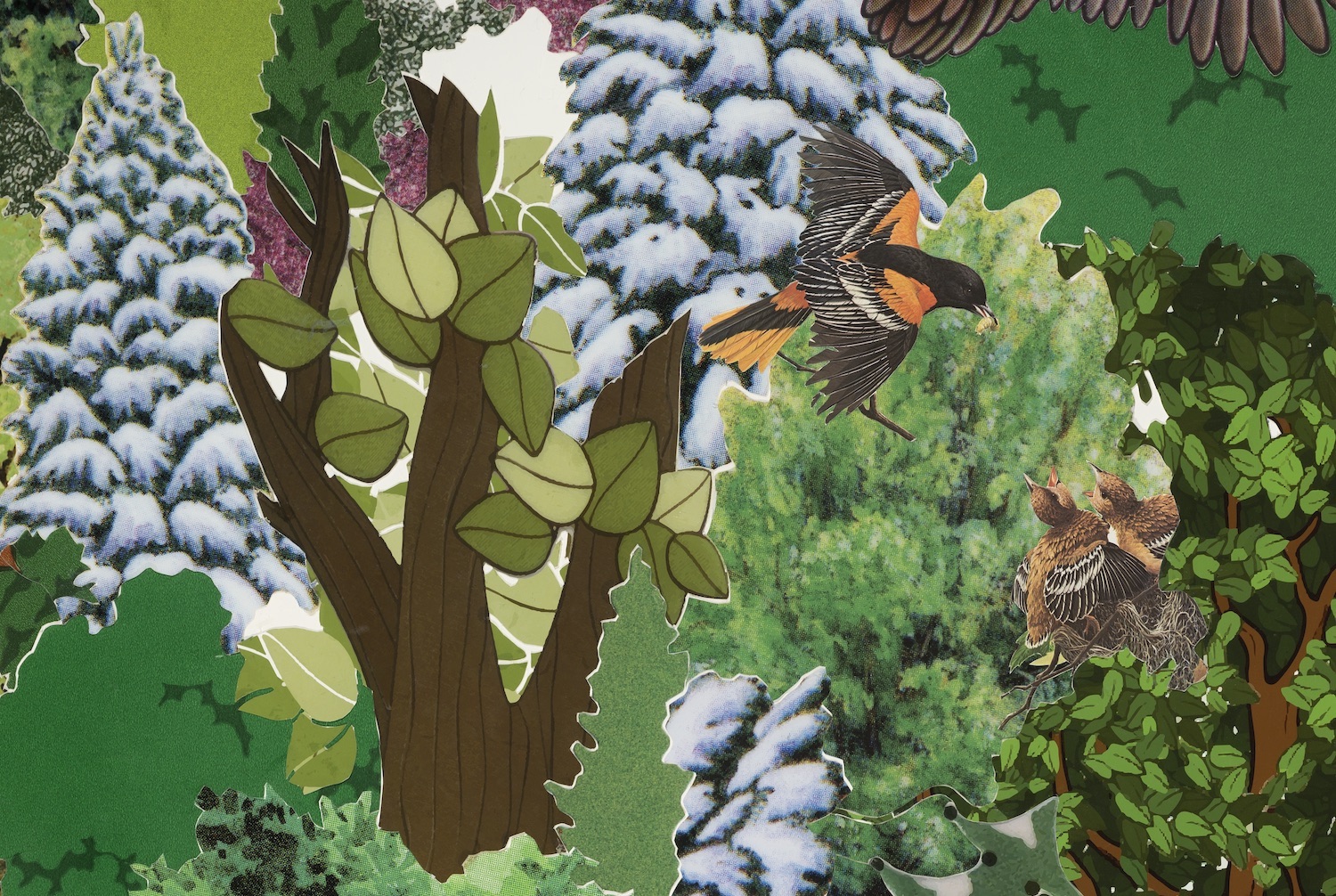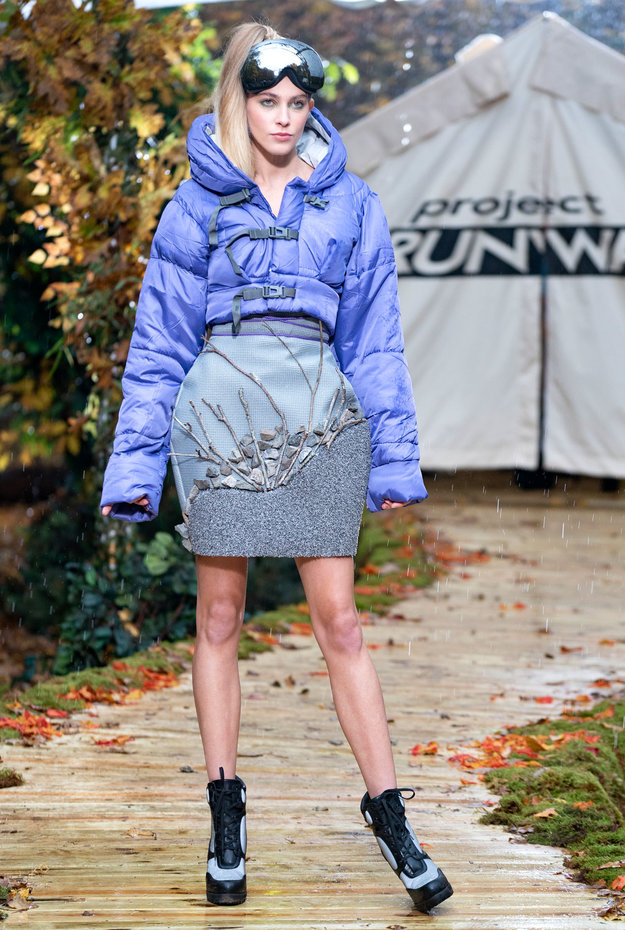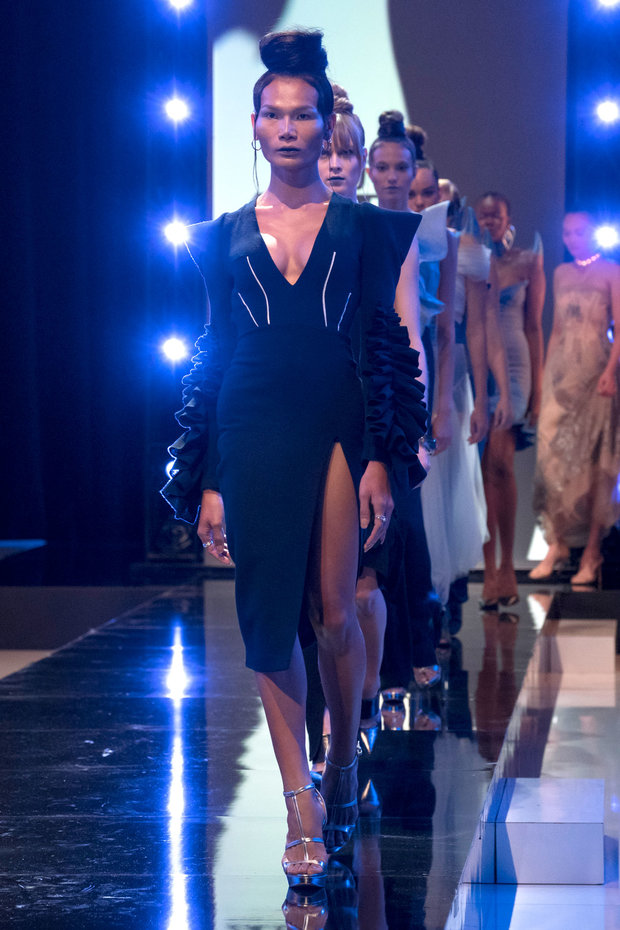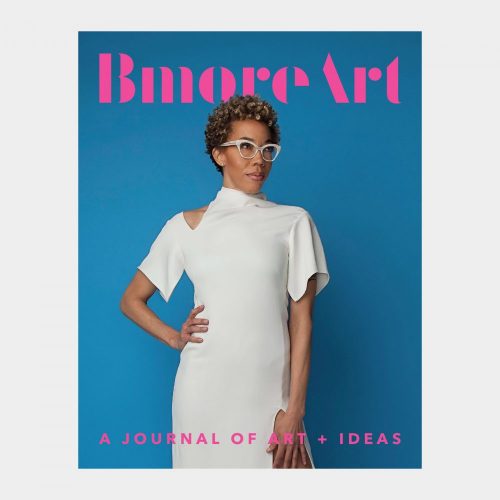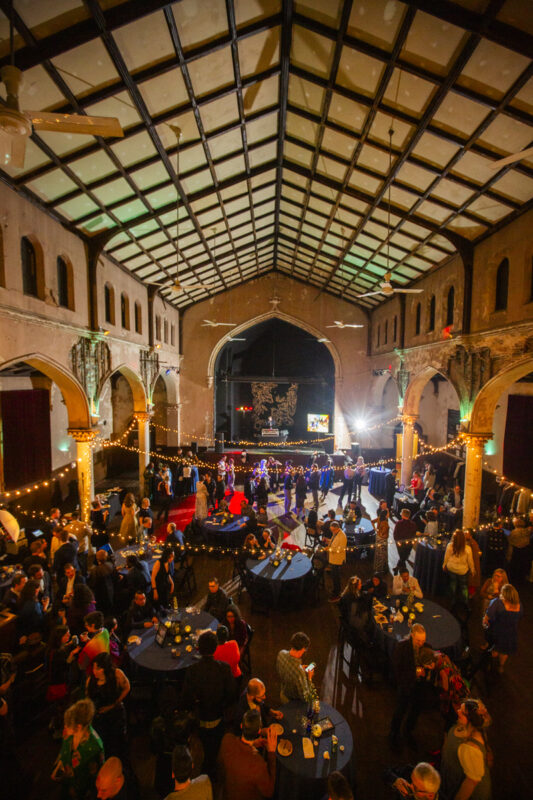If you have been watching Season 17 of Project Runway, or attended the giant party hosted at The Walters for the Baltimore-based fashion designer competing this season, you know the thrill of cheering on hometown talent. Whether he is crafting a “survival chic” outfit out of found materials in the woods, building a lewk around one single pattern, winning at luxe streetwear inspired by Dapper Dan (!), or just being all-around charming a là reality tv star mojo, Bishme Cromartie is a Baltimore-based artist worth celebrating.
For those who knew the designer way back when, all of this national tv attention feels well-deserved. Not only is he a visionary creator, Bishme is industrious, generous, and so not a diva (thankfully, Baltimore weeds these folks out). We wrote about Bishme in our Issue 05 (Beauty) and included his garments in our Wearable Art photo essay in Issue 06 (Home).
This essay by Mai Sennaar gives those new to Bishme’s work a chance to catch up and then tune in with newfound appreciation as the season progresses on Bravo! (Cara Ober)
 Winning on Episode 5! Bishme Cromartie’s streetwear look is inspired directly from Baltimore and includes golden embroidered lettering on the back spelling out his neighborhood: GREENMOUNT. As winner of the competition, this ensemble was sold directly by Bravo! and you can get your own hometown or neighborhood on the back.
Winning on Episode 5! Bishme Cromartie’s streetwear look is inspired directly from Baltimore and includes golden embroidered lettering on the back spelling out his neighborhood: GREENMOUNT. As winner of the competition, this ensemble was sold directly by Bravo! and you can get your own hometown or neighborhood on the back.
***
Evolving Patterns: Bishme Cromartie by Mai Sennaar
Being self-taught might explain Bishme Cromartie’s disinclination to follow any one designer or stream of consciousness in the fashion industry. His work reveals a wide breadth of influences and a prodigious versatility, exceeding conventional aesthetic boundaries in Western fashion. He solidifies his place as an emerging innovator with every new collection. And he’s captured international attention and critical acclaim as a Baltimore-based designer, his unabashed approach to style a powerful expression of our city’s heritage.
Squinting against a brisk March wind, I cross familiar terrain to reach Bishme’s studio. It’s not quite 10 a.m. and a trio of men have already gathered in a liquor store doorway. A tie-dye summer dress hangs outside of an incense shop. Near the Light Rail tracks a brownstone mansion, the title of a bank etched into its stone, has been repurposed into a mosque. Young black men with red beards from the dye of henna wear Middle Eastern garb and slings full of scented oils across their chests. Well below the high-rises of the Inner Harbor’s investment firms, they sustain an economy and a community all their own.
Cromartie meets me with a smile at the spotless double doors of his studio. It’s a neat, modest space with wooden warehouse floors. Thick shades block the enormous windows, leaving the room dim and intimate, alternative soul playing in the background. A signed photo of Andra Day, one of the celebrities he’s styled, hangs above his desk chair. I compliment his workspace’s organization and cleanliness; he apologizes for specks of dust on the rug. Initially, he stares away when he speaks, looking back at me every few sentences with kind, vibrant eyes.
 Bishme Cromartie with model Janae Edley at The Walters, photographed by Ryan Stevenson
Bishme Cromartie with model Janae Edley at The Walters, photographed by Ryan Stevenson
Cromartie, 26, was selected by Vogue as one of three fashion designers to watch from LA Fashion Week 2017, and his work has already appeared on runways, celebrity clients, and in the pages of the world’s leading fashion publications. With the support of his sister, an upstate New York native, Cromartie began traveling to New York City to assist on photo-shoots as a teenager. His big break came in 2009, when a social-media post of his dresses caught the attention of a New York stylist he’d been following for some time.
When the stylist asked him if he had any floor-length gowns readily available, Cromartie, then 17, said yes, even though he only had the fabric. This was on a Monday and the finished dresses were needed by a Wednesday photo shoot. “I knew I could whip it up,” he says.
Inspired by Project Runway’s pressure-cooker challenges, he considered the deadline an opportunity to prove himself. He completed the dresses in time and, upon arriving at the photo set, discovered that his work would be featured in a shoot for Vogue Italia and ELLE Vietnam. That’s when Cromartie saw his dresses next to those of Christian Siriano, the winner of the previous year’s Project Runway season. Cromartie would go on style Eva Marcille and many other celebrity clients the following year.
“I can’t even make up the stuff that’s happened to me,” he admits, shaking his head.
As with all artists, his ideas and style continue to evolve. “Early on, I was avant-garde,” he says. “Really into shapes and dramatic stuff. I thought to be a designer you had be very bold and flashy. Now, I see the progression.”
Cromartie says that while he initially tried to incorporate narrative into his designs, storytelling has become a central tenet of his work now. He’s also relying more on subtlety to express his vision. He has no idol in particular and admires the work of many designers. His desire to express himself through design seems partly to be an extension of a personal identity that was clear to him early on.
Cromartie’s streetwear remixes and transcends familiar aesthetics of contemporary urban style. With the integration of leather fabrics, extensive ruffle work, very high splits, and form-fitting silhouettes, Cromartie plays with a bold, seductive, and overtly sexual representation of the female form. He elevates his impression of femininity with innovative fabric combinations, distinct cuts, and unusual sculptural choices. These more sensual looks have adorned the likes of singer Fantasia Barrino at a pre-Grammy party and model/actress Karrueche Tran. She sports a Cromartie pink leather off-the-shoulders shirt in a characteristically coy photo for a magazine spread. His work has the spark and decadence to excite and attract Hollywood divas, but he also wields poise and complexity with ease.
What’s most remarkable about Cromartie’s artistry is his audacious versatility. Looks from his Fall 2018 collection combine fringes and regal, draping lines with fitted, accentuated waistlines. In his gowns, he often delivers a full-on glamour reminiscent of Oscar de la Renta’s work, or the iconic costumes of Edith Head during Hollywood’s Golden Age. That boldness and clarity of intention consistently runs through his work. His style mesmerizes, seduces, and stops the show.
Such artistry is what first attracted him to fashion. He recalls being at his cousin’s apartment where they were about to watch Roots, but he didn’t feel like. I join him in a laugh—we were both too young to appreciate the 1977 original airing of Alex Haley’s masterwork, part of a generation that felt ambivalent about the somewhat awkward TV miniseries that made history by attracting the largest television viewership of any series when it premiered on ABC.
 Bishme Cromartie with model Janae Edley at The Walters, photographed by Ryan Stevenson
Bishme Cromartie with model Janae Edley at The Walters, photographed by Ryan Stevenson
Instead, “I just was looking through my cousin’s magazines, stumbling through Harpers Bazaar and Vogue,” he continues, “I’ll never forget it.” He was struck by the imagination and heightened reality of the art direction. The clothes in these high-fashion magazines were art. That’s when he started to dream of creating his own clothing.
For Cromartie, Baltimore has been a nourishing ground for this creative impulse. He grew in Waverly, a neighborhood that had heavy gang-related activity, though he points out that the environment was not sordid. “There weren’t killings,” he recalls. “The gang members mostly protected and looked out for their community and made sure that everybody was OK. No one looked at me differently once it got out that I made clothes, and that encouraged me even more—I knew my city was behind me.”
He cautions against any perpetuation of the stigmas associated with Baltimore’s urban communities. Baltimore “made my imagination stronger and it showed me reality,” he says. “It also taught me that where you are is temporary.”
His first showcase was at the Eubie Blake Cultural Center, Baltimore’s community arts staple. He has always found tremendous inspiration from his city, even during the death of Freddie Gray and the subsequent uprising, which he says “affected my art and my pockets.”
Two of his clients were flying in for a fitting when the uprising ensued, and they canceled, forfeiting their deposits out of fear for their safety. Witnessing the chaos and strength of the city’s youth engaged Cromartie emotionally. He saw the uprising as a plea for help. From his studio window, he watched the protesters. He saw the beauty in their expression of internalized pain and frustration.
“I got inspired,” he says, adding that he created a dress that night that represented a wing covering and saving the city. “The caption was ‘Pray for Baltimore.’ I felt a cry, a plea from people being tired of not being heard.”
Across all kinds of media, Cromartie considers art a unique and important platform to address our city’s history of injustice and discrimination. He believes that art can help us heal from our past by serving as a neutral space for the expression of raw emotions in a way that can be beautiful and promote understanding and dialogue.
I tell him that I was first struck by his unusual name. Bishme. The name is derived from Bismillah, an Arabic pronouncement meaning “in the name of God” that appears as the opening phrase of most chapters in the Qur’an.
“It took me a long time to stand firm in that name,” Cromartie says. “But the older I got, the more I wanted to live up to it.” He was named by his mother, who, though not Muslim herself, respected some Islamic tenants.
“I think she was molding me into a leader,” he says. “For me, that doesn’t mean you’re always in the front. It really can be about making sure that everyone moves forward as one. Once I realized I had a powerful name, I knew I had to move in a powerful way.”
 Model Janae Edley wearing Bishme Cromartie at The Walters, photographed by Rarah
Model Janae Edley wearing Bishme Cromartie at The Walters, photographed by Rarah
Editor’s Note: This profile was originally published in The BmoreArt Journal of Art + Ideas: Issue 06
Text by Mai Sennaar
Photos by RaRah (Ryan Stevenson)
Photo Assistant Dave ‘Wavey’ Anderson III
Model Janae Edley
Makeup by Ashley Briscoe
